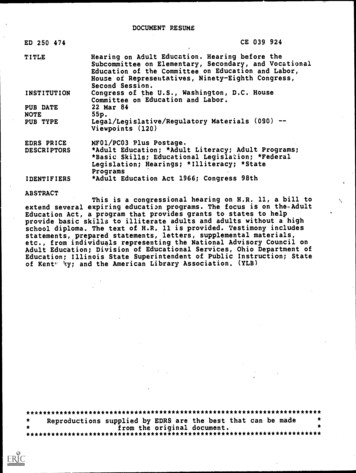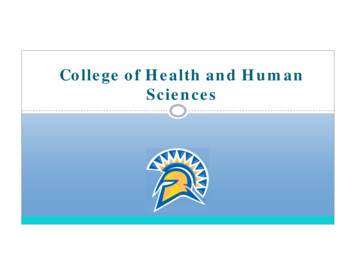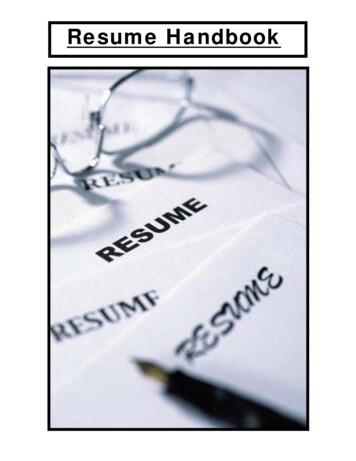
Transcription
DOCUMENT RESUMECE 039 924ED 250 474TITLEINSTITUTIONPUB DATENOTEPUB TYPEEARS PRICEDESCRIPTORSIDENTIFIERSHearing on Adult Education. Hearing before theSubcommittee on Elementary, Secondary, and VocationalEducation of the Committee on Education and Labor,House of Representatives, Ninety-Eighth Congress,Second Session.Congress of the U.S., Washington, D.C. HouseCommittee on Education and Labor.22 Mar 8455p.Legal/Legislative/Regulatory Materials (090) -Viewpoints (120)MF01/PC03 Plus Postage.*Adult Education; *Adult Literacy; Adult Programs;*Basic Skills; Educational Legislation; *FederalLegislation; Hearings; *Illiteracy; *StatePrograms*Adult Education Act 1966; Congress 98thABSTRACTThis is a congressional hearing on H.R. 11, a bill toextend several expiring education programs. The focus is on the,,AdultEducation Act, a program that provides grants to states to helpprovide basic skills to illiterate adults and adults without a highschool diploma. The text of H.R. 11 is provided. Testimony includesstatements, prepared statements, letters, supplemental materials,etc., from individuals representing the National Advisory Council onAdult Education; Division of Educational Services, Ohio Department ofEducation; Illinois State Superintendent of Public Instruction; Stateof Kent, tcy; and the American Library Association. **************************Reproductions supplied by EDRS are the best that can be madefrom the original ******************************
HEARING ON ADULT EDUCATIONIlHEARINGBEFORE THEtanSUI3COMMITTE14.3 ON ELEMENTARY, SECONDARY, ANDVOCATIONAL EDUCATIONCZ)OF THECOMMITTEE ON EDUCATION AND LABORHOUSE OF REPRESENTATIVESNINETY-EIGHTH CONGRESSSECOND SESSIONONH.R. 11TO EXTEND THROUGH FISCAL YEAR 1989 THE AUTHORIZATION OFAPPROPRIATIONS FOR CERTAIN EDUCATION PROGRAMS,AND FOR OTHER PURPOSESHEARING HELD IN WASHINGTON, DC, ON MARCH 22, 1984Printed for the use of the Committee on Education and LaborU.S. DEPARTMENT OF EDUCATIONOF EDUCATIONNATIONAL INSTITUTEINFORMATIONEDUCATIONAL RESOURCESCENTER IERICIdournent has been reproduced asreceived from the person or organization11, Thisoriginating it.been made to improveMinor changes havereproduction quality.stated in this docuPoints of view or ()pinionsrepresent vtficief MEment do riot necessarilyposition or policyU.S. GOVERNMENT PRINTING OFFICE35 -s12WASHINGTON : 19842
COMMITTEE ON EDUCATION AND LABORCARL D. PERKINS, Kentucky, ChairmanAUGUSTUS F. HAWKINS, CaliforniaJOHN N. ERLENBORN, IllinoisWILLIAM D. FORD, MichiganJAMES M. JEFFORDS,.V.ermontJOSEPH M. GAYDOS, PennsylvaniaWILLIAM F. GOODLING, PennsylvaniaWILLIAM (BILL) CLAY, MissouriE. THOMAS COLEMAN, MissouriMARIO BIAGGI, New YorkTHOMAS E. PETRI, WisconsinIKE ANDREWS, North CarolinaMARGE ROUKEMA, New JerseyPAUL SIMON, IllinoisSTEVE GUNDERSON, WisconsinGEORGE MILLER, CaliforniaSTEVE BARTLETT, TexasAUSTIN J. MURPHY, PennsylvaniaRON PACKARD, CaliforniaAALTASAR CORRADA, Puerto RicoHOWARD C. NIELSON, UtahDALE E. KILDEE, MichiganROD CHANDLER, WashingtonPAT WILLIAMS, MontanaTHOMAS J. TAUKE, IowaRAY KOGOVSEK, ColoradoJOHN McCAIN, ArizonaMATTHEW G. MARTINEZ, CaliforniaMAJOR R. OWENS, New YorkFRANK HARRISON, PennsylvaniaFREDERICK C. BOUCHER, VirginiaGARY L. ACKERMAN, New YorkSALA BURTON, CaliforniaCHARLES A. HAYE3, IllinoisDENNIS E. ECKART, OhioTIMOTHY J. PENNY, MinnesotaSUBCOMMITTEE ON ELEMENTARY, SECONDARY, AND VOCATIONAL EDUCATIONCARL D. PERKINS, Kentucky, ChairmanWILLIAM D. FORD, MichiganWILLIAM F. GOODLING, PennsylvaniaIKE ANDREWS, North CarolinaRON PACKARD, CaliforniaGEORGE MILLER, CaliforniaMARGE ROUKEMA, New JerseyBALTASAR CORRADA, Puerto RicoSTEVE GUNDERSON, WisconsinDALE E. KILDEE, MichiganSTEVE BARTLETT, TexasPAT WILLIAMS, Montana;TOWARD C. NIELSON, UtahAUGUSTUS F. HAWKINS, CaliforniaROD CHANDLER, Washington,MARIO BIAGGI, New York(Ex Officio)FREDERICK C. BOUCHER, VirginiaTHOMAS J. TAUKE, IowaGARY L. ACKERMAN, New YorkSALA BURTON, CaliforniaCHARLES A. HAYES, Illinois
c''CONTENTS'Irti'4.1Hearing held inText of H.R. 11,/it,1.iitif%IV ' 'it I. ; '1. 'Z': .'?li1, ; ily., it,1984Statement of:Dorsey, Patric, council member. accompanied by Richard Ventura, executive director, National Advisory Council on Adult EducationMiller, James W., director, Division of Educational Services, Ohio Department of EducationPrepared statements, letters, supplemental materials, etc.:Dorsey, Patric, National Advisory Council on Adult Education, preparedstatement ofGill, Donald G., Illinris State Su -rintendent of Education, preparedstatement ofMcDonald, Alice, superintendent of public instruction, State of Kentucky,prepared statement ofMiller, James W., director, Division of Educational Services, Ohio Department of Education:Adult Basic Education, State of OhioAnnual Report Highlights, fiscal year 1983 (table)Economic and Employment Impact Data (table)Prepared statement ofTotal enrollment (table)Wedgeworth, Robert, executive director, 'American Library Association,Chicago, IL, prepared statement of'Page12311114484510.10117949
HEARING ON ADULT EDUCATIONTHURSDAY, MARCH 22, 1984HOUSE OF REPRESENTATIVES,SUBCOMMITTEE ON ELEMENTARY, SECONDARY,AND VOCATIONAL EDUCATION,COMMITTEE ON EDUCATION AND LABOR,Washington, DC.The subcommittee met, pursuant to call, at 9:40 a.m., in room2261, Rayburn House Office Building, Hon. Carl D. Perkifts (chairman of the subcommittee) presiding.Members present: Representatives Perkins, Andrews, Hayes,Good ling, Gunderson, and Nielson.Staff present: John F. Jennings, counsel; Nancy L. Kober, legislative specialist; Electra Beahler, Republican education counsel; andRichard Di Eugenio, Republican senior legislative associate.Chairman PERKINS. This morning the Subcommittee on Elementary, Secondary and Vocational Education is continuing hearingson H.R. 11, a bill to extend several expiring education programs.Today we will focus on the Adult Education Act.The Adult Education Act, first enacted in 1966, was most recently amended in 1978. This program provides grants to States to helpprovide basic skills to illiterate adults and adult without a highschool diploma.(1)
298111 CON(11{ ESS1sT Si ssioNH. R. 1 1To. extend through fiscal year 1989 the aulliorkuition of appropriations for certaineducation programs, 1111(1 for other purposes.IN THE 11011SE OF REPRESENTATIVESJANUARY 3, 1983Mr. I'EIthINS introduced the following bill; which was referred to the CommitteeOn Education and LaborA BILLTo extend through fiscal year 1989 the authorization of appropriations for certain education programs, and for other purposes.1Be it enacted by the Senate and House of Representa-2lives of the United States of America in Congress assembled,3ADULT EDUCATION4SECTION 1. (a) Section 311(b) of the Adult Education5 Act (20 U.S.C. 1208a(b)) is amended by strip' ig out "Octo-6 her 1, 1983" and inserting in lieu thereof "October 1, 1989".6
21(h) Section 313(b) of such Act is amended by striking2 out October 1, 1984" and inserting in lieu thereof "Gctober341, 1990".(e) Section 315(a) of such Act .9 amended by striking5 Out "for fiscal year 1983" and inserting in lieu thereof "for6 each succeeding fiscal year ending prior to October 1, 1989".7(d) Section 316(e) of such Act is amended by striking8 out "October 1, 1983" and inserting in lieu thereof "October9 1, 1989".10(e) Section 318(0 of such Act is amended by striking out,11"four" and inserting in lieu thereof "nine".12BILINGUAL EDUCATION13Sc. 2. (a) Section 702(b)(1) of the Bilingual Education14Act (20 U.S.C. 3222(b)(1)) is amended by striking out "for15 the fiscal year 1983" and inserting in lieu thereof "for each16 succeeding fiscal year ending prior to October 1, 1089".17(14 Section 702(b)(2) Of such Act is amended by striking18 wit "each of the two succeeding fiscal years" and inserting in19 lieu thereof "each of the succeeding fiscal years ending prior20 to October 1, 1989".21(c) Section 723(a)(2) of such Act is amended by striking22 out. "Oetobff 1, 1983" and inserting in lieu thereof "October23 1, 1989".24(d) Section 731(c) of such Act is amended by striking25 out "February 1, 1980, 1982, and 1984" and inserting in
431lieu thereof "February 1 of 1980, 1982, 1984, 1986, 1988,2 and 1990".3(e) Section 742(f) of such Act is amended by striking out4 "October 1, 1983" and inserting in lieu thereof "October 1,51989".6(f) Section 751(c) of such Act is amended by striking out7For fiscal year 1983" and inserting in lieu thereof "for each8 succeeding fiscal year ending prior to October 1, 1989".IMPACT AID910SEC. 3. (a) The Act of September 30, 1950 (Public Law11874, Eighty-first Congress; 20 U.S.C. 236) is amended by12 striking out "October 1, 1983" each place it appears in sec13 tions 2(a), 3(b), 4(a), and 7(a)(1) and inserting in lieu thereof14 "October 1, 1989".1516(b) The Act of September 23, 1950 (Public Law 815,Eighty-first Congress; 20 U.S.C. 631) is amended-17(1) by striking out "September 30, 1983" in sec-18tion 3 and inserting in lieu thereof "September 30,191989"; and20(2) by striking out "October 1, 1983" in section2116(a)(1)(A) and inserting in lieu thereof "October 1,221989".2324WOMEN'S EDUCATIONAL EQUITYSEc. 4. Section 938 of the Women's Educational25 Equity Act of 1978amended by striking out "three suc-8
541ceeding fiscal years" and inserting in lieu thereof "succeed.2 ing fiscal years ending prior to October 1, 1989".INDIAN EDUCATION34SEC. 5. (a) Section 303(a)(1) of the Indian Elementary5 and SecondarySchoolAssistanceAct(20U.S.C.6 241bb(a)(1)) is amended by striking out "October 1, 1983"7 and inserting in lieu thereof "October 1, 1989".8(b) Sections 422(c), ,423(a), and 442(a) of the Indian9' Education Act (20 U.S.C. 887c-1(c), 887c-2(a), 1221g(a))10 are each amended by striking out "October 1, 1903" and111213inserting in lieu thereof "October 1, 1989".(c) Section 1005(g) of the Elementary and SecondaryEducation Act of 1965 (20 U.S.C. 3385(g)) is amended by'14 striking out "October 1, 1983" and inserting in lieu thereof15 "October 1, 1989".1,,,'LLENDER FELLOWSHIPS1617SEC. 6. Section 5 of the joint resolution of October 19,18972 (Public Law 92-506) is amended by st: iking out "Octo-19 ber 1, 1982" and inserting in lieu thereof "October 1, 1989''.ASBESTOS DETECTION AND CONTROL2021SF c. 7. (a) Section 5(a)(1.)(A) of the Asbestos School22 Hazard Detection. and Control Act of 1980 (20 U.S.C.23 3604(a)(1)(A)) is amended by striking out the last sentence.24(b) Section 12(a)(1)(A) of such Act is amended by strik-25 ing out "the succeeding fiscal year" and inserting in lieu3t -872 0-84---29
651thereof "each of the succeeding fiscal years ending prior to2 October 1, 1989".3(c) 3ection 12(a)(1)(B) of such Act is amended by strik4 ing out "the fiscal year ending September 30, 1982" and5 inserting in lieu thereof "each of the fiscal years ending prior6 to October 1, 1989".7(d) Section 12(a)(2) of such Act is ainended by striking8 out "September 30, 1983" and inserting in lieu thereof "the9 end of the fiscal year following the fiscal year for which ap-10 propriated".11GENERAL EDUCATION PROVISIONS ACT12Sec. 8. (a) Section 405(b)(7) of the General'Education13Provisions Act (20 U.S.C. 1221e) is amended by striking out14"October 1, 1983" and inserting in lieu thereof "October 1,151989".16(b) Section 406(g) of such Act is amended by striking17out "October 1, 1983" and inserting in lieu thereof "October181, 1989".0
7'Chairman PERKINS. Our panel today consists of Mr. James W.Miller, director, Division of Educational Services, Ohio Departmentof Education; and Mrs. Patric Dorsey, council member, NationalAdvisory council on Adult Education. Come around both of you.Weierc.,, me you before the committee. We'll start with you Mr.Miller. Proceed in any manner you wish.[Prepared statement of James W. Miller follows:]PREPARED STATEMENT OF JAMES W. MILLER, DIRECTOR, DIVISION OF EDUCATIONALSERVICES, OHIO DEPARTMENT OF EDUCATIONMr. Chairman and Members of the Committee, my name is James Miller, Director of Educational Services for the Ohio Department of Education. On behalf of Dr.Franklin B. Walter, our State Superintendent of Public Instruction, and the nearly60.000 adults enrolled this year in Ohio's Basic Education program, I thank you forthis opportunity to appear before you to speak on behalf of the Adult Education Act.I have also served as President of the American Association for Adult and Continuing Education and hope to bring both a state and national perspective for your consideration.Before moving to specific comments about the Administration's proposed Almendments to the bill and to other recommendations for the Committee to consider, Iwould like to begin by commending the Chairman and Members of the Committeefor your continued support of this important program for the past nineteen years.These.words are said not merely to compliment the committee. More importantly,they convey our deep appreciation for inyesting federal dollars in a program whichhas had a tremendous positive impact, both economically and personally, on thelives of -thousands of adults and children since 1966. My use of the term "adult"should come as no surprise to you but the use of the word "children" might. I in-clude children because of the dramatic impact inade on a child whose mother,father, older brother or sister, or sometimes a grandparent, demonstrates the courage to return to school to learn to read and write for the first time.There is no greater demonstration of the importance of an education than shownby adult students in their quest for freedom and dignity. Educators throughout thenation can tell you about the irilproved attendance, improved self-discipline and increased achievement shown by children whose parents are ABE students,The Federal, State and Local partnership in adult education has a proven trackrecord. This record is without major blemishes. The Adult Education Act is simpleto administer and delivers the vast percentage of funds to provide direct services tostudents.The Administration has recommended some changes in the legislation which rep-resent a retreat rather than progress. These changes could cause a drastic loss ofpower in what is now a well-tuned engine.Let me be more specific in my comments about the Administration's proposedchanges by addressing seven key issues.I. Matching and maintenance of effort requirements should both be deleted. Sucha change would be highly detrimental to the adult education program. The match-ing and maintenance of effort requirements have been largely responsible for therapid increase of state and local funds spent for adult education. Difficult economictinies corrhined with the lack of much political clout on the part of ABE studentscould easily result in a significant reduction of state support if matching and maintenance of effort requirements are dropped.Ii. my own State of Ohio, which has been severely affected by recent economicconditions, the matching requirement was the critical factor in maintaining statesupport in our recent appropriations process. Federal support cannot be expected tomeet the total needs of the program. Continued emphasis on state support is a must.f'onsideration could be given to increasing the state matching requirement over alive-year period. This suggestion would require further study to determine the effects on individual states.:2. The 5 percent limitation on State administration should be deleted.Corningfrom a state education agency representative, this statement may come as a shock.Nonetheless, our experience shows that 5 percent is ,quite adequate to administerthe' program. In Ohio, we have consistently spent less than 5 percent for administration and have reallocated some administrative funds to local schools to provide additional services for students. From a national perspective, I have some fear that ifthere is no cap on administrative expenses, in times of severe fiscal cutbacks, somestates may be tempted to shift other SEA staff to adult education because of the
8availability of funds. While one could possibly argue the appropriateness of that decision, I would submit that removing the administrative cap and reducing programfunds is an unnecessary temptation, especially when the future of many adults literally depends on the ABE program.8. Up to 50 percent of local administrative costs of programs and projects could bepaid from funds under the actThis recommendation is self-defeating; quite often,the highest number of poor and undereducated adults live in some of our poorestschool districts. These school districts include urban cities as well as schools in extremely rural areas. This change could have the effect of steering funds away fromadults most in need.4. Private, for profit, organizations would be eligible to carry out programs underthe art.This recommendation is repugnant. The use of the word repugnant is notmeant !o impugn profit-making institutions because our free enterprise system isthe foundation of our entire economic structure. However, one must seriously question the rationale and motives of using the plight of the illiterate adult for profitmaking purposes when funds are already insufficient, and where a successful delivery system currently exists with public and private achools, community colleges,technical schools, vocational schools, and many public and private non-profit agencies.Such a change would create innumerable legal and audit problems, create the possibility of fly-by-night programs quickly organized to serve profit interests morethan student interests, and create a system impossible to monitor and accountableto no one.5. The Secretary would be permitted to set aside up to 5 percent of the appropriation for national programs.This provision, if adopted by the Committee, should notgo into effect until triggered by a much higher appropriation; and amount of 125million would seem to be a reasonable base. Even then, questions must be raised asto how such funds would be utilized; a 2 percent cap might be more reasonable.6. The 20 percent cap on institutionalized adults would be deleted.The removalof the cap poses a major threat to the overall program which is apparently not preceived by. the Administration. Given the politics and/or possible litigation in certainstateS, it is entirely within the realm of possibility that a governor or judge coulddecree that a significant portion of the state allocation be directed toward the corrections system .or to the thousands of severely retarded adults moving from stateinstitutions into community halfway houses. This is not to say these adults do notdeserve ABE service. They are entitled to service and such adults are enrolled-ineach of the states. However, the 20 percent cap guarantees that funds are availablefor many kinds of adults, including adults on public assistance, unemployed adults,and students learning English as a i4econd language. A major emphasis must remainon those adults who can become taxpayers instead of taxusers. According to the Department of Education staff, only 4 percent of funds nationally are currently spenton institutionalized adults. The old question of "if it ain't broke why fix it ?" shouldbe raised on this issue, There is ample opportunity to increase services for institutionalized adults without changing c.4rrent law.7. The 10 percent retained for teacher training and special demonstration projectsshould be deleted.This proposal has merit as long as there is language which authorizes expenditures of funds for such purposes.The following are specific recommendations for improving current legislation.1. Sections 311, 316, 317 and 318, which address the elderly, Native Americans,IndoChinese and immigrants, should be deleted. Such students are now eligible forservices and do enroll in the ABE program.2. Rather than language calling for such sums as may be necessary, new languageshould contain incremental authorizations of %180, 205, 255 and 280 million.Given the national concern for improved literacy, these amounts are actually tooconservative.3. TI- 10 percent requirement to spend funds for teacher training and specialdemonstration projects should be deleted. Language should be retained to allow ex-penditures for this purpose up to a limit of a set percentage. Five or ten percentwould be acceptable limits.4. If it is desirable to allow the Secretary of Education to have discretionaryfunds, such a provision should not become effective until at le'ast an appropriationlevel of 125 million would he reached. Consideration should be given to a 2 percentset-aside rather than the 5 percent requested by the Administration.5. Consideration could be given to revising the definition of literacy. In t e'view ofamany, literacy is more than the important basic skills of reading, writing anematics. The skills necessary to function effectively in our complex Ame ic n socie12
9ty differ greatly from the literacy skills that may be adequate in a country such asPakistan,i. The linkage of ABE with Chapter 1 and programs funded through the JobsTraining Partnership Act should be stressea as much as possible, Students served inABE are comprised of many parents of Chapter 1 children as well as thousands ofparticipants in JTPA programs.7. Data collection needs to be improved. Care should be talt.n to insure that datacolintion mandated in the law should be of a priority nature, capable of being collected, and not unduly burdensome on state and local agencies. No data systemshould be designed without state and local input, beginning with the initial designof the system, Past experience indicates that our involvement usually came afterthe fact.8. The 20 percent caps on GED and services to institutionalized adults should bemaintained as well as the 5 percent cap on State Administration, The three-yearstate plan was a good change and should be continued.9. The National Advisory Council for Adult Education should be maintained. Theyhave pro', ided effective visibility for adult education.recognized that without reauthorization by the committee, nothing is pos10. Itsible. Given yOur continued leadership, an equally important action would be togreatly increase the appropriation for this program. Current efforts are helpinghundreds of thousands of adults. Countless numbers of volunteers are helping manyother adults. Yet, we are merely reaching the tip of the iceberg.In closing, I would like to quote Mr. Leo Albert from the Association of AmericanPublishers who said, "The ugliest censor of them all, and the one that worries memost, is illiteracy; for illiteracy blocks more people from what they need to know inorder to be happy and free to be productive citizens of this society than all othercensors combined.A recent news release from one of the distinguished members of this Committee,Mr. Paul Simon, one of the leading supporters of literacy efforts, included this statement: "We have hidden the reality of adult illiteracy, much as we once hid the problem of mental retardation. I see it among my Illinois constituents when I ask peopleto sign what we call a 'consent form' to help in problems with Social Security andother agencies. Adult illiteracy is a financial drain on our society in a great manyways, and it is growing."The costly effects of illiteracy are reflected dramatically in funds spent for publicaw,istance programs, for unemployment compensation, for maintaining our institutions for adult and youth offenders, for training costs incurred in business and in-dustry and military, and for time lost in preparing adults to participate in JTPAand similar programs.The damage does not fall upon the illiterate alone; it affects society in areas otherthan economics. I would submit that political leaders such as yourselves can be lim-ited by the wisdomor lack of wisdomof our citizens. Dictators can marshal! theilliterate fur unlimited purposes. In a dictatorship, the illiterate are prisoners of thetyrant. In a democracy, a wise leader can become the prisoner of ignorance. Indeed,global illiteracy in the long run is a far greater danger to our future than the IronCu.tain.Thank you Mr. Chairman and Members of the Committee for your support. Although you seldom have the pleasure of seeing the actual difference the programmakes in the lives of individual adults, your support provides the basis for that difference.'The young man died because he couldn't read a plainly worded safety warning.lie couldn't read the words that would have saved his life." (From an episode of"Quincy", entitled "A Loss of Words", shown on NBC. in 1983.)ADULT BASIC EDUCATION STATE OF OHIOFiscal year--Total enrollmentImpact dataCompleted Adult Education Program through eighth grade.I2Passed general educational developatenl lest3Graduated from adult secondary ed.coion after starting in adultbasic ,4394.8725,8867322,9541,1521,2761,65/Ij
10ADULT BASIC EDUCATION STATEOF OHIO-ContinuedFiscal year19/94. Enrolled in another education/training programexperience gained in ABE.asa1980198219811983result 96431,7736. Are enrolled in program who are receiving public assistance9,12111,94912,0E713,50814,1977. Were removed from public assistance rolls1,1351,6061,7001,6381,5438. Obtained jobs as a result of experience gained in program2,5763,6492,6912,1532,3425. Are enrolled in program who are unemployed9. Changed to or were upgraded toexperience in programabetterjob asaresultof1,1441,6651,3631,1741,01610. Registered to vote for the first time698-1;5421,439-1;4131,60411. Received U.S. citizenship18125819411614012. Received driver's license13. Received training in completing income tax 3,8394,6957,5327,6234,1,u6,5505,5515,4076,22514. Are enrolled in programs that were establistitii for institutionalizedpersons15. Are enrolled in programs for persons of limited English-speakingabilitySTATE OF OHIO ADULT BASIC EDUCATION FISCAL YEAR 1983 ANNUAL REPORT HIGHLIGHTSPARTICIPANTS BY ETHNIC GROUPPercentNumber2150.415,24429.22,3244.5American Indian or Alaskan r of participants by sex.Women .Men . . .Number ol participants by age:16 to 41 .45 to 64 .65-plus.411.1Number of participants by level:Level I.44,216857,92415Level II.Staff:1,181Number of personnelEquivalent number ol full lune. personnel381Number taking training836Contact hours and cost4,542,013Total number of contact hours .87Average number of contact hours per student 1 21Cost per hour of instructionCost per person. 111.06ADULT BASIC EDIKATION, STATE OF OHIO, FISCAL YEAR 19113Ohio's Adult Basic Education Prootm provides services to residents who: (1) haveless than a twelfth grade education or its functional equivalence and, (2) aro notcurrently required to he enrolled in school.14
11Free instruction is offered in basic and life skills, general work skills, secondarycompletion (General Educational Development Test preparation), and English as aSecond Language.In fiscal year 1983, a total of 52,140 Ohio adults were enrolled. Of' these, 85 per-cent we?. runctioning at or below the eighth grade equivalence level at the time oftheir enri. Tient; 61 percent were unemployed; and 27 percent were receiving publicassistance.Economic and employment impact dataExpenditures:FederalState ts:1,543 adults removed from public assistance for savings of2,342 adults secured new employment for income of1,016 adults received job promotions for increased income of16,054,732116,319,0561422,545I Public assistance savings based on rumber of removals times annual benefit of 3,924.Income estimates based on number of adults multiplied by minimum hourly wageof 3.35/hour for new employees and an additional .20/hour for those receiving jobpromotions.For more information, contact: The Ohio Department of Education, Division ofEducational Services, 65 South Front Street, Room 811, Columbus, Ohio 43215, 614 466- 5015.STATEMENT OF JAMES W. MILLER, DIRECTOR, DIVISION OFEDUCATIONAL SERVICES, OHIO DEPARTME7IT OF EDUCATIONMr. MILLER. Mr. Chairman and members of the committee, I amJames Miller, director, Educational Services, from Ohio. On behalfof Dr. Franklin B. Walter, our State superintendent of public instruction, and the nearly 60,000 adults enrolled this year in Ohio'sAdult Basic Education Program, I thank you for this opportunityto appear before you to speak on behalf of the Adult EducationAct. I have also served as president of the American Associationfor Adult and Continuing Education and hope to bring both a Stateand national perspective for your consideration.Before moving to specific comments about the administration'sproposed amendments to the bill and to other recommendations forthe committee to consider, I would like to begin by commendingthe chairman and the members of the committee fir. your continued support of this important program for the past 19 years. Thesewords are said not merely to compliment the committee. More importantly, they convey our deep appreciation for investing Federaldollars in a program which has had a tremendous positive impact,both economically and personally, on the lives of thousands ofadults and children since 1966.My use of the term "adult" should come as no surprise to youbut the use of the word "children" might. I include children because of the dramatic impact made on a child whose mother,father, older brother or sister, or sometimes a grandparent, demonstrates the courage to return to school to learn to read and writefor the first time.There is no greater demonstration of the importance of an education than shown by adult students in their quest for freed
Dorsey, Patric, council member. accompanied by Richard Ventura, execu-tive director, National Advisory Council on Adult Education . Secondary and Vocational Education is continuing. hearings. on H.R. 11, a bill to extend several. expiring education programs. Today we will focus on the Adult Education Act. The Adult Education Act, first .










